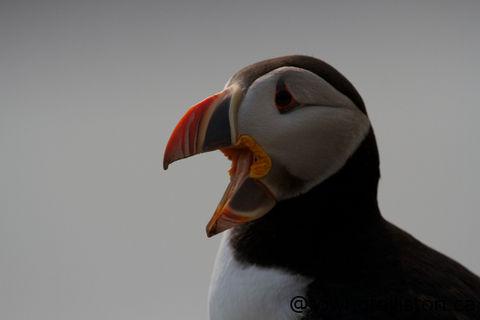The Elliston Community Website has been online since Sept. 25th, 2000 promoting our region
Puffins

The Atlantic Puffin, known for their sharp black and white coat and multi-colored beaks, migrate to our region every year during the warmer months. Thousands of people every year make the journey to our area just to catch a glimpse of a puffin up close. Puffins are the provincial bird of Newfoundland and Labrador, and our community features one of the best observation areas to grab photos and observe their seasonal breeding routines.




The Puffin Viewing Site
Elliston’s Puffin Viewing Site is just a short five-minute walk from the main road situated on a sharp turn - See Map #6. It is roughly halfway between Sandy Cove Beach and the Puffin Craft Shop found on the nearby Maberly Loop. In fact, it is one of the closest land views of puffins in North America. The best time to view puffins is from May to September when they come to Elliston for the mating season. This site hosts thousands of nesting pairs.
Visitation to the puffin site is 100% free and a great experience provided you are mindful of your surroundings, especially around the edges of cliffs.
NOTE: DOGS & DRONES ARE NOT PERMITTED ON SITE
Background on Puffins
Elliston was once known as Bird Island Cove and with good reason. It is home to numerous seabirds and also the Atlantic Puffin. The puffin is also the official bird of Newfoundland and Labrador since 1992.
The Atlantic Puffin is one of four puffin species and the only one that lives on the North Atlantic Ocean. The Latin term is Fratercula arctica, with fratercula meaning "little brother" and arctica meaning "north." This scientific name can be translated as "little brother of the north." The puffin is also known as the "sea parrot" due in part to its interesting colouring. In addition to nesting pairs at the site there are more on North Bird Island and elsewhere.
Puffins have a unique colouring. An adult has a bright orange, yellow and bluish bill with matching orange feet. A puffin’s face is primarily white with some additional colouring at the base of the bill around their eyes. Their heads, back, and wings are black while the underbelly is white. Both sexes have similar appearances, although males tend to be slightly larger than the females. They are true seabirds, spending most of their time swimming, diving and feeding. Puffins can dive for distances of up to 70 m (200 ft) and are propelled by their powerful wings, which are adapted for swimming (See Video). They use their webbed feet as a rudder while submerged. Puffins collect several small fish, such as herring, sprats, zooplankton, fish (shellfish), sand eels, when hunting. They use their tongues to hold the fish against spines in their palate, leaving their beaks free to open and catch more fish.
Puffins establish burrows on grassy cliffs. They will also nest amongst rocks. Male puffins perform most of the work of clearing out the nest area, which is sometimes lined with grass, feathers or seaweed. The only time spent on land is to nest which is about five months per year. Mates are found prior to arriving at the colonies, and mating takes place at sea. The Atlantic Puffin is sexually mature at the age of 4–5 years. The species is monogamous and has biparental care. A single-egg clutch is produced each year, and incubation responsibilities are shared between both parents. Total incubation time is around 39–45 days, and the chick takes about 49 days to fledge. At fledging, the chick leaves the burrow alone, and flies/swims out to sea, usually during the evening. Contrary to popular belief, young puffins are not abandoned by their parents. The average bird lives about 20 years.
Puffins return to the area in May and usually stay until the end of September.
The Puffin King
While at the Puffin Viewing Site don’t forget to snap a photo of the Puffin King (rock formation on the right as the land narrows). He forever sits on his stone throne keeping a watchful eye on all who visit the site.


.png)





















